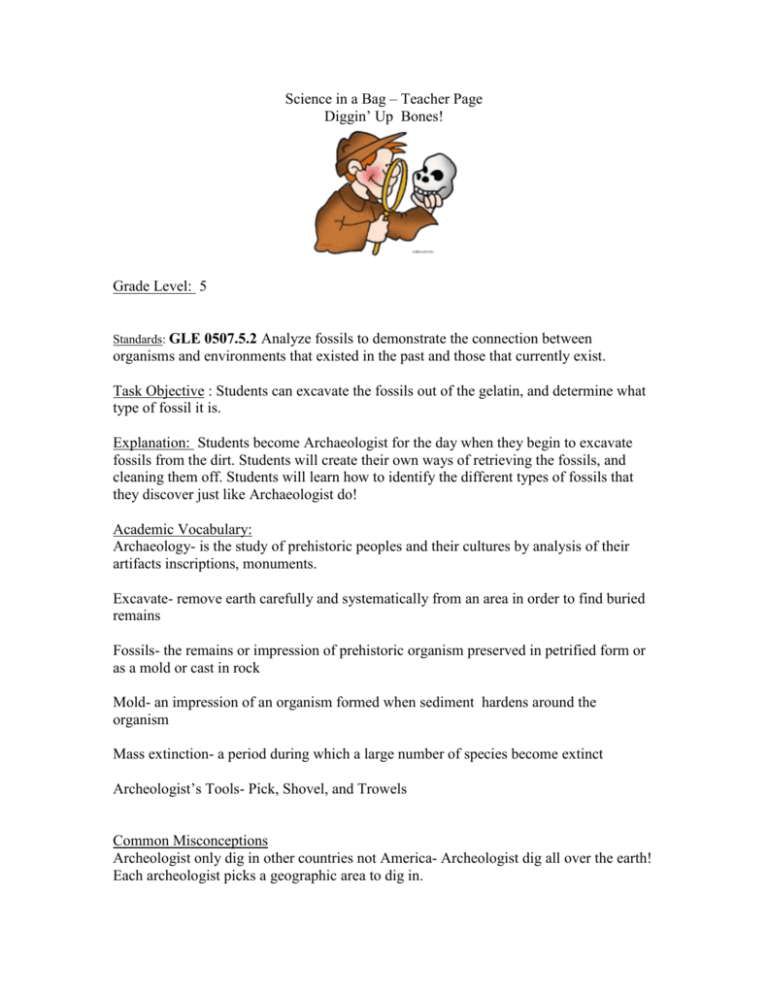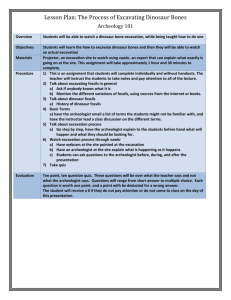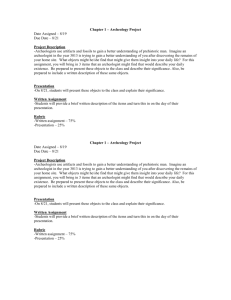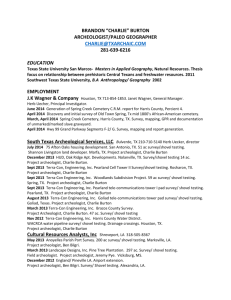digging for fossils
advertisement

Science in a Bag – Teacher Page Diggin’ Up Bones! Grade Level: 5 Standards: GLE 0507.5.2 Analyze fossils to demonstrate the connection between organisms and environments that existed in the past and those that currently exist. Task Objective : Students can excavate the fossils out of the gelatin, and determine what type of fossil it is. Explanation: Students become Archaeologist for the day when they begin to excavate fossils from the dirt. Students will create their own ways of retrieving the fossils, and cleaning them off. Students will learn how to identify the different types of fossils that they discover just like Archaeologist do! Academic Vocabulary: Archaeology- is the study of prehistoric peoples and their cultures by analysis of their artifacts inscriptions, monuments. Excavate- remove earth carefully and systematically from an area in order to find buried remains Fossils- the remains or impression of prehistoric organism preserved in petrified form or as a mold or cast in rock Mold- an impression of an organism formed when sediment hardens around the organism Mass extinction- a period during which a large number of species become extinct Archeologist’s Tools- Pick, Shovel, and Trowels Common Misconceptions Archeologist only dig in other countries not America- Archeologist dig all over the earth! Each archeologist picks a geographic area to dig in. Archeologist dig up things that they shouldn’t be- Archeologist main goal is to find items that can tell a little bit about the past. Archeologist does this through collecting data that can tell us human patterns and ways from the past. In today’s time, laws have been put into place to protect important artifacts from being disturbed. Archeologist will run out of things to dig up- Archeologist will always have things to dig up. There are things that die and get buried everyday. This has been happening as long as mankind has been on earth, so archeologist will never run out of things to dig up. Real World Connection It is so important in today’s time for us to understand the past. It is vital for students to understand that fossils are so important and can tell us many things about the creatures that lived in the past. The things they ate, hunted, and even the tools that helped them survive. Our world today is so easy to live in, and our students need to understand that it wasn’t always this way. Connections Across the Curriculum Social Studies: 5.57 Write an informative text about the Holocaust and it’s impact. ( If Archeologist went to the concentration camps and began digging; they would probably find many fossils of people who died there.) Math: CCSS.MATH.CONTENT.5.MD.B.2: Make a line plot to display a data set of measurements in fractions of a unit (1/2, 1/4, 1/8). Use operations on fractions for this grade to solve problems involving information presented in line plots. (Students could measure their fossils they found and create a line plot) Science- 0507.5.5 Use fossils to match a previously existing organism with one that exists today. ( Student can determine what fossils that they dig up still live today and what they are) References https://www.pinterest.com/- Activity https://quizlet.com/9316902/fossil-terms-flash-cards/- More definitions https://images.google.com/- pictures Science in a Bag – Student Page Diggin’ up Bones! Grade Level: 5th Grade Standards :GLE 0507.5.2 Analyze fossils to demonstrate the connection between organisms and environments that existed in the past and those that currently exist. Task Objective: Students can excavate the fossils out of the gelatin, and determine what type of fossil it is. Materials Needed: Pumpkin Pick- Excavation Tool Pumpkin Scraper- Excavation Tool Paint Brushes Skelton Dirt Sand Water Procedures 1. Read Directions Carefully Before Beginning 2. Do vocabulary sorting in baggies first 3. Pick out excavating tool and begin digging 4. Dig until you find 1 fossil 5. Once you have retrieved your fossil, wash off all the excess dirt 6. Wash your fossil off in the bowl of water and dry off with a paper towel 7. Get your Skelton worksheet, and identify the body part on the fossil you found 8. Color the body part you found on you Skelton worksheet 9. Put worksheet in your interactive notebook 10. Clean up by washing off your tools and placing where the next group may use them Academic Vocabulary Students will need to match the word to the correct definitions. Assessment Fact 32: Matching Cards Students need to match the vocabulary words with the pictures and then match the pictures with the definitions. Clean-up Wipe off the desk from any spilt water, and wash off your excavation tools from any left over dirt. Place your excavation tools where the next group can find them









